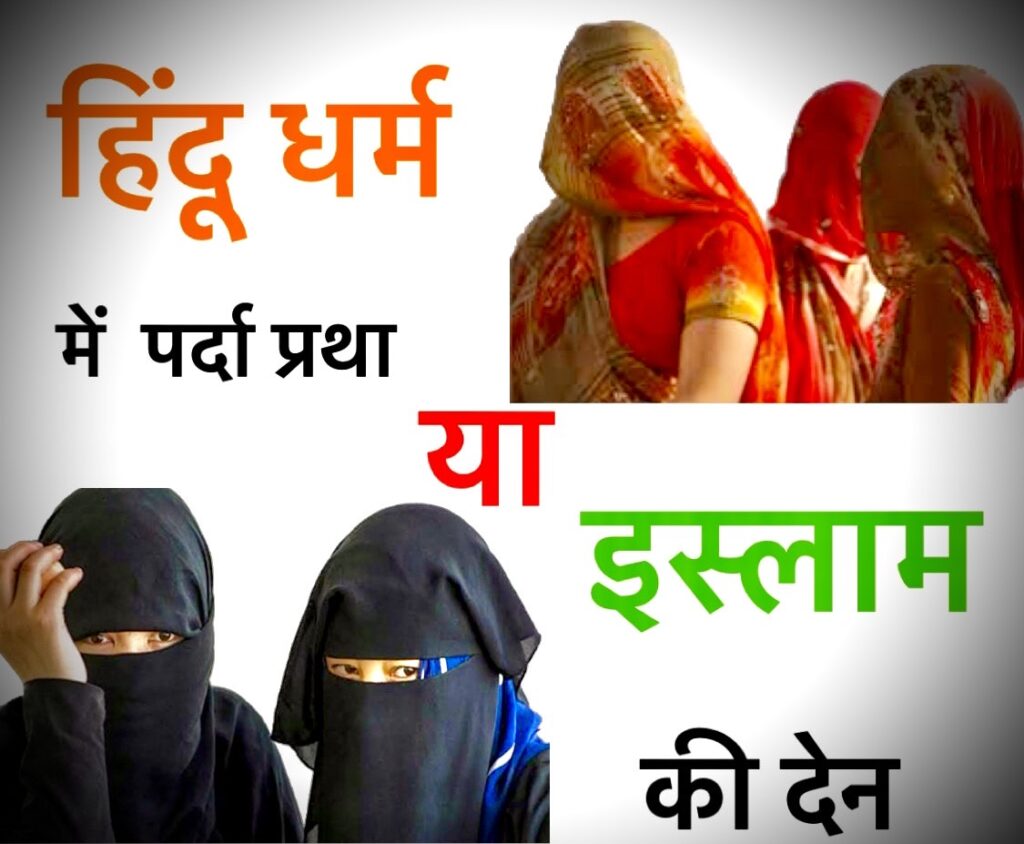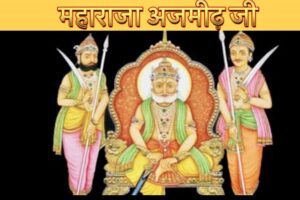PARDA PRATHA (PURDAH SYSTEM )IN INDIA

पर्दा प्रथा
क्या हिंदू धर्म में पर्दा प्रथा का कोई रूप है ? अगर नहीं तो पर्दा प्रथा किसने देन है ?
पर्दा प्रथा की शुरुआत
पर्दा एक इस्लामी शब्द है जो अरबी भाषा में फ़ारसी भाषा से आया ।
मुस्लिम समुदाय के अलावा किसी भी धर्म जाति में नहीं थी यह प्रथा ।
सभी मुस्लिम देशों में ये प्रथा शामिल थी और आज भी है ।
पर्दा प्रथा का भारत में विस्तार
भारत में इसकी शुरुआत 12 वी सदी से मानी गई है ।
मुग़ल काल में इस प्रथा ने अपनी जड़ें काफ़ी मज़बूत कर ली थी और इसका विस्तार राजपूती समाज में देखा गया । आजकल राजपूत समाज और उत्तर भारत के काफ़ी हिस्सा में यह प्रथा देखी जा सकती है ।
पर्दा का इतिहास
पर्दा प्रथा का एक पहलू है बुर्का ।
बुर्का एक तरह का घूँघट है, जो मुस्लिम समुदाय की महिलाएँ और लड़कियाँ कुछ खास जगहों पर खुद को पुरुषों की निगाह से अलग या दूर रखने के लिये इस्तेमाल करती हैं। भारत में हिन्दुओं में पर्दा प्रथा इस्लाम की देन है। इस्लाम के प्रभाव से तथा इस्लामी आक्रमण के समय आक्रमणकारियों से बचाव के लिये हिन्दू स्त्रियाँ भी पर्दा करने लगी थीं। इस प्रथा ने मुग़ल शासकों के दौरान अपनी जड़ें काफ़ी मज़बूत की। वैसे इस प्रथा की शुरुआत भारत में12वीं सदी से मानी जाती है। इसका ज्यादातर विस्तार राजस्थान की राजपूत जाति में था। 20वीं सदी के उतरार्द्ध में इस प्रथा के विरोध के फलस्वरूप इसमें कमी आई।
भारत के बाहर के देशों का इतिहास उठाकर देखें तो ईशा के जन्म से 500 वर्ष पूर्व यूनानी औरते किसी अंगरक्षक के बिना बाहर नहीं निकलती थी और ना ही घर पे उनके पति के द्वारा बुलाए गये मेहमान के सामने आती थी ।
भारत में पर्दा प्रथा इसका इतिहास
वेदों और संहिताओं में इस प्रथा का कोई उल्लेख नहीं मिलता है ।
ऋग्वेद में विवाह के समय एक बाद दर्शाती है कि भारत के इतिहास में इस प्रथा का कोई रूप नहीं है
ऋग्वेद में लोगो को विवाह के समय कन्या की तरफ़ देखने को कहाँ गया –
“”यह कन्या मंगलम है एकत्र हो और इसे देखो “”
“”इसे आशीष देकर ही तुम लोग घर जा सकते हो “”
विद्वानों के मतानुसार रामायण और महाभारत में भी पर्दा प्रथा का कोई रूप नहीं था ।
अजंता और साँची की कलाकर्तियों में भी स्त्रियों को बिना घूँघट के दिखाया गया है ।
मनु और यागवलक्य ने स्त्रियों के जीवन शैली के बारे में काफ़ी नियम बताए है लेकिन पर्दा को इन नियमों में कोई स्थान नहीं दिया गया है।
मध्य काल मे पर्दा का इतिहास
16वीं शताबादी में रुस में पिता और भाई को पुत्री और बहन का मुँह देखने पर रोक थी।
17वीं शताब्दी में इंग्लैंड की महिलाए अकेले यात्रा नहीं कर सकती थी और ना ही सार्वजनिक सभा में कोई। अत कर सकती थी अगर वह कहीं सभा में कुछ बोल देती तो इसे काफ़ी अपमानजनक माना जाता था ।
भारत में मुस्लिम आक्रांताओं के साथ साथ पर्दा प्रथा ने अपने पैर जमाने शुरू कर दिये ।
उत्तरी और पूर्वी भारत में पर्दा प्रथा सर्वसाधारण पाई जाती है जिसकी शुरुआत मुस्लिम आक्रमणकारियों के आने से हुआ ।
सर्वप्रथम हिन्दू सरदारों और उच्च वर्ग ने शासकों का अनुसरण कर अपने अंत:पुरों में इस प्रथा को लागू किया फिर उनका अनुसरण कर समाज के अन्य वर्गों ने भी उसे अपना लिया।
स्त्री शिक्षा समाप्त होने व छोटी उम्र में विवाह होने के कारण स्त्रियों का सम्मान गिरने लगा ।
15,16वीं शताबादी तक यह प्रथा जीवनशैली बन गई ।
भारत के स्वतंत्रता आंदोलनों में बहुत सी महिलाओं ने इस पर्दा को छोड़कर आंदोलनों में बढ़ चढ़कर भाग लिया। यह शिक्षा का प्रभाव था
लेकिन आश्चर्य यह है की जिस प्रथा का भारत जैसे देश में कोई लेना देना नहीं था जो कुप्रथा मुस्लिम समुदाय में थी , ब्रिटिश काल में पली बढ़ी वह कुप्रथा आज भी आधुनिक भारत में पैर जमाए हुए है ।
यह प्रथा औरतों को मुस्लिम आक्रमणकारियों से छिपाए रखने के लिए शुरू की गई थी । ताकि कोई मुस्लिम ग़लत नज़र ना डाल सके ।
लेकिन आज ना ही मुस्लिम आक्रमणकारी है और ना ही समाज में इस प्रथा का इतना बोल बाला है लेकिन इसके साथ साथ उत्तर भारत में राजस्थान, हरियाणा में ये प्रथा आज भी है ।
उन्हें यह समझना होगा कि हमारे समाज, धर्म में महिलाओं को हमेशा से पुरुषों के समान अधिकार मिले है , पुरुषों के सुख दुख में ह्मेसा कंधे से कंधा मिलाकर साथ दिया है महिलाओं ने ।
जब मुग़ल ही गये तो उनकी प्रथा का हमारे देश में क्या काम ??
स्वयं को शीसे के सामने खड़ा कीजिए अगर आपको उसमे औरंगज़ेब और ख़िलजी जैसी मानसिकता का इंसान नज़र आटा है तो आप पर्दा प्रथा को उचित ठहरा सकते है अन्यथा भारतवर्ष में इसका कोई काम नहीं
इसके बावजूद भी अगर आप पर्दा प्रथा को सही ठहराते है तो आप में और ख़ुद के घर की औरतों को बुर्का पहनाने वालों में कोई फ़र्क़ नहीं
PARDA PRATHA (PURDAH SYSTEM ) IN INDIA
Is there any form of purdah system in Hindu religion? If not, then who introduced the purdah system?
Beginning of purdah system
Purdah is an Islamic word which came into Arabic from the Persian language. This practice was not prevalent in any religion or caste except the Muslim community. This practice was prevalent in all Muslim countries and is still prevalent today.
EXPANSION OF PARDA IN INDIA
In India it is considered to have started from the 12th century. During the Mughal period, this tradition had strengthened its roots and its expansion was seen in the Rajputi society. Nowadays this practice can be seen in Rajput society and many parts of North India.
HISTORY OF CURTAIN ( PARDA)
Burqa is one aspect of purdah system. Burqa is a kind of veil, which women and girls of Muslim community use in certain places to keep themselves separate or away from the gaze of men. The practice of purdah among Hindus in India is the gift of Islam. Due to the influence of Islam and during the Islamic invasion, Hindu women also started veiling to protect themselves from the invaders. This tradition strengthened its roots during the Mughal rulers. However, this practice is considered to have started in India from the 12th century. Most of its expansion was in the Rajput caste of Rajasthan. In the latter half of the 20th century, it declined as a result of opposition to this practice.
If we look at the history of countries outside India, 500 years before the birth of Isha, Greek women did not go out without a bodyguard nor did they come to the house in front of guests invited by their husbands.
PARDA SYSTEM IN INDIA ITS HISYORY
There is no mention of this practice in the Vedas and Samhitas.
The timing of marriage in the Rig Veda shows that there is no form of this practice in the history of India.
Where in the Rigveda are people told to look at the girl at the time of marriage?
“”This is Kanya Mangalam, gather together and see it”” “”
You guys can go home only after blessing him””
According to scholars, there was no form of purdah system even in Ramayana and Mahabharata.
Even in the artworks of Ajanta and Sanchi, women have been shown without veil. Manu and Yagavalkya have given many rules regarding the lifestyle of women but purdah has not been given any place in these rules.
HISTORY OF THE VEIL IN THE MIDDLE AGES
In 16th century Russia, fathers and brothers were prohibited from seeing their daughters and sisters.
In 17th century England, women could not travel alone or attend public meetings. Therefore, if she had said something in the meeting, it would have been considered quite insulting.
Along with the Muslim invaders, the purdah system started gaining a foothold in India. The practice of purdah is common in northern and eastern India, which started with the arrival of Muslim invaders.
First of all, Hindu chieftains and upper class followed the rulers and implemented this practice in their inner cities, then following them, other sections of the society also adopted it.
Due to the end of women’s education and marriage at a young age, the respect of women started declining. This practice became a lifestyle by the 15th and 16th centuries.
During the freedom movements of India, many women left the veil and actively participated in the movements. it was the effect of education But the surprising thing is that the practice which had nothing to do with a country like India, which was a bad practice in the Muslim community, which grew up during the British period, is still gaining a foothold in modern India.
This practice was started to keep women hidden from Muslim invaders. So that no Muslim can cast a wrong glance. But today neither Muslims are invaders nor this practice is so prevalent in the society, but at the same time this practice is still prevalent in Rajasthan and Haryana in North India.
They have to understand that in our society and religion, women have always had equal rights as men, women have always stood shoulder to shoulder with men in their happiness and sorrow. When the Mughals are gone, what is the use of their customs in our country??
Stand yourself in front of the mirror, if you see a person with the mentality of Aurangzeb and Khilji, then you can justify the practice of purdah, otherwise it has no use in India. Despite this, if you justify the practice of purdah, then there is no difference between you and those who wear burqa to their own women.







